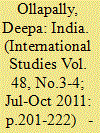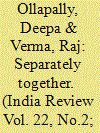| Srl | Item |
| 1 |
ID:
122920


|
|
|
|
|
| Publication |
2011.
|
| Summary/Abstract |
This article argues that India's foreign policy preferences cannot be understood without referring to its state identity as it has evolved over time. The ambivalence that is evident throughout much of India's post-Independence history lies in deep-seated identity sources-a unique mixture of post-colonial nationalism, civilizational exceptionalism and secular democracy. India's identity has played out in foreign policy to place an inordinate amount of importance to strategic autonomy but with a normative aversion to power politics and use of force. This has led to an ambivalence that many observers find hard to understand. This orientation is now coming under increasing strain, because of the rise of a realist strand of thinking challenging the country's traditional normatively driven foreign policy outlook. Realist thinking is posing as a distinct alternative that calls for a more proactive and power infused policy stance. The rise of China in India's neighbourhood is giving greater weight to realist arguments. Although India's core value of strategic autonomy is still in force in Indian foreign policy, the article suggests that it is taking on a different form that is more nuanced, more flexible and adaptable. As such, India may now be particularly well positioned to play the role of a 'bridging power' more effectively, matching its state identity with a new evolving international role. India's membership in groups ranging from G-20 and Brazil, Russia, India, China and South Africa (BRICS) to India, Brazil, South Africa (IBSA) and ASEAN Regional Forum (ARF), and its being a serious contender for a permanent seat in the UN Security Council, gives India distinct opportunities and status to utilize a greater mix of soft and hard power options than in the past. India may well be at the moment of overcoming its historical ambivalence to power-driven policies and purposeful action.
|
|
|
|
|
|
|
|
|
|
|
|
|
|
|
|
| 2 |
ID:
006853


|
|
|
|
|
| Publication |
Bangalore, National Institute of Advanced Studies, 1997.
|
| Description |
xii, 111p.
|
|
|
|
|
|
|
|
|
|
|
|
Copies: C:2/I:0,R:0,Q:0
Circulation
| Accession# | Call# | Current Location | Status | Policy | Location |
| 038750 | 355.825119/OLL 038750 | Main | Withdrawn | General | |
| 038751 | 355.825119/OLL 038751 | Main | On Shelf | General | |
|
|
|
|
| 3 |
ID:
106689


|
|
|
| 4 |
ID:
189439


|
|
|
|
|
| Summary/Abstract |
This article highlights the convergence and divergence between India and the US pertaining to China under the Trump administration. Given Trump’s forceful personality and apparent chemistry with Modi, it is tempting to attribute bilateral relations to individual leaders. However, systemic pressures due to shared concerns over China’s rise and aggressive behavior played a significant role in keeping relations on track and ultimately deepening them. This led to increasing Indo-US cooperation in the Quad especially after the Galwan Valley cash in June 2020 although India initially feared entrapment. While there was convergence on the broad contours of the threat of a Sino-centric Asia, coming to agreement on specific strategies to prevent it faced its share of challenges with Trump wanting New Delhi to do more to counter China and do it faster. There was also divergence related to India’s continuing attachment to strategic autonomy underwritten by a multipolar world order, and Indian and American definitions of the boundaries of the Indo-Pacific and how the priority areas of each differed.
|
|
|
|
|
|
|
|
|
|
|
|
|
|
|
|